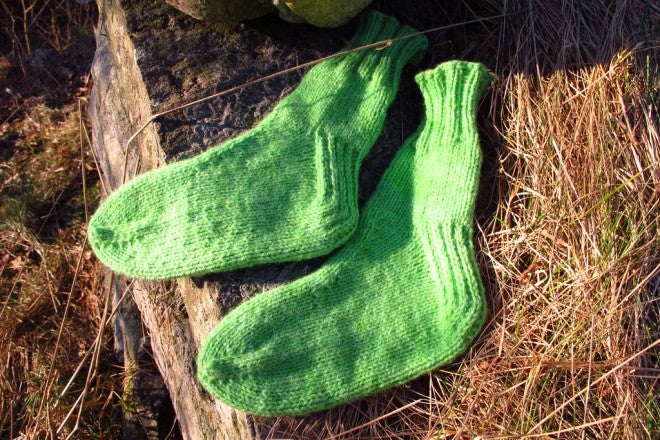Ontario Outdoors: Socks, Liners, Insoles, and other Hiking Must-Haves
AllOutdoor Staff 04.01.15

In previous articles, we’ve covered selecting, fitting, buying and maintaining footwear. By this point, I’m sure that all but the most serious foot-fetishists are begging for a speedy end. But hey, there’s another hugely important facet of footwear to cover first: what you put in your shoes and what you put on them.
Sock it to Me
If you spent time and money on good boots and shove a pair of baggy cotton socks in them, the result will be the same as if you went backpacking in flip-flops: sore feet and blisters. Proper socks are crucial to a good hike in Ontario, so don’t set foot on the trail without first encasing it in the right sock.
Feet can produce more than a liter of moisture each per day. Cotton holds on to this moisture, softening feet and creating the ideal climate for blisters. Additionally, cotton doesn’t hold it’s shape easily, leading to bags and wrinkles that distribute friction unevenly over your foot, again, causing rawness and blisters. Aim for a sock made from a synthetic fiber, wool, or a mixture of the two. Of course, there are better and worse socks, but as long as it’s not cotton, you’re headed in the right direction!
Gear Tips:
High End: Point6 makes three lovely wool-blend sock dedicated to the “triple crown” of hiking trails. Better yet, sales of this sock support the Pacific Crest Trail Association, Appalachian Trail Conservancy, and Continental Divide Trail Alliance.
Middle-of-the-Road: Thorlos makes a solid acrylic hiking sock that isn’t flashy, but it’s durable as all heck. I’ve walked 600 miles in a pair of these!
It’ll work in a pinch: A cheap acrylic sock is better than a cheap cotton sock. Not ideal, but better.
Consider a Liner
For years I’ve heard hikers say “Man, you gotta wear TWO pairs of socks!” And that’s what I did: stuffed two huge pairs of woolen socks into a pair of boots. This was only effective in smashing my toes together so tightly they went numb–a positive thing considering I could barely feel the massive blisters!
But this advice was true, if not a bit confusing. You should wear two pair of socks, but the inner pair of socks should be a thin liner sock. Blisters come from friction. i.e. two surfaces rubbing together. A liner sock encases your foot in a thin, breathable layer of fabric that fits the contours of your little piggies so closely that any friction occurs on the OUTSIDE of the liner between the liner and the sock instead of between the sock and your foot!
Gear Tips:
High End: Smartwool merino wool liner socks are dreamy. They are light, breathable snug-fitting, and resist odor! They aren’t the most durable, but while they last, you will enjoy them enormously.
Middle-of-the-Road: Wigwam polypropylene liners are the next best thing. They’re not quite as soft as merino, but they’re way more durable. Just don’t dry them on hot. They’ll melt!
It’ll work in a pinch: A thin men’s dress sock, or a even (gasp!) a women’s stocking works very well.
Get the Gaiters
You’ve got your socks, you’ve got your liners, and you’ve got your boots. And, if you don’t got your gaiters too, you’ll have a boot full of rocks, mud, and sticks! Gaiters are tubes of rugged material that fit over the top of your shoes and snug around your ankles. They look a bit odd, but they work amazingly well to prevent a bunch of debris from landing in your shoes. As an added bonus, gaiters can prevent ticks from crawling up your legs in the backcountry. Give them a pre-treatment with a Pyrethrum repellent compound and you’ve got even better tick protection.
Gear Tips:
High End: Hillsound’s Armadillo gaiters are super burley gaiters designed for winter use. This tough gaiter may be a bit hot for summer, but it’s so durable it’s a good trade-off!
Middle-of-the-Road: Eastern Mountain Sports low gaiters are made from a soft, breathable, soft-shell material. They aren’t water proof, but they’re highly water-resistant and cool and warm weather.
It’ll work in a pinch: I’ve been known to tuck my hiking pants into my socks and secure them with a rubber band in the absence of gaiters. No shame – it works!
Insoles
Unfortunately, many good boots come with not-so-good “factory” insoles. These thin liners do little to support your foot and can bunch underfoot, leading to blisters or muscular pain. An after-market insole offers more support, but don’t embark on the insole journey without some thought.
After-market insoles add volume to your boots and sometimes take up a full size’s worth of volume in the shoe. Try on an insole in your “everyday” shoes before adding them to your hiking boot, and don’t hesitate to consult with a podiatrist of sports’ medicine specialist if you have any questions about how after-market insoles might affect your gait
Gear Tips:
High End: Superfeet make a category-defining insole solution. They have many, many choices with different volumes, arch positions, and textures. If your outfitter carries Superfeet insoles, give them a try and see if they improve the comfort of your footwear.
Middle-of-the-Road: Shock Doctor makes insoles that are a bit cushier than Superfeet. In my experience, they’re best for people that need more padding and less anatomical adjustment. They are super comfy.
It’ll work in a pinch: I’ve been known to customize recalcitrant insoles with everything from duct tape to cardboard chunks. If it hurts less and you don’t have anything better, go for it! I’ve even propped up flat spots in insoles with checking gum!